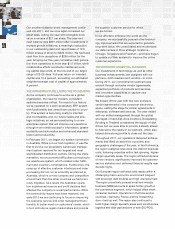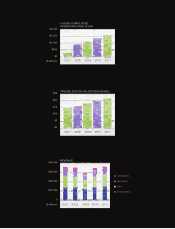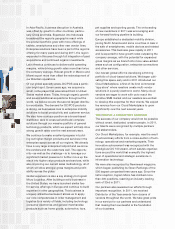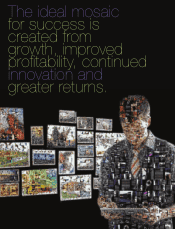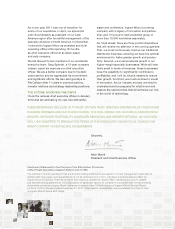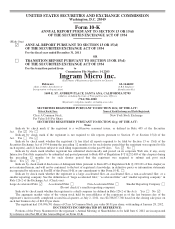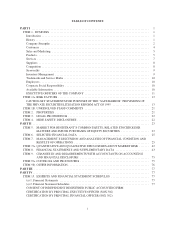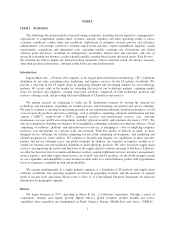Ingram Micro 2011 Annual Report Download - page 4
Download and view the complete annual report
Please find page 4 of the 2011 Ingram Micro annual report below. You can navigate through the pages in the report by either clicking on the pages listed below, or by using the keyword search tool below to find specific information within the annual report.
Our excellent balance-sheet management contin-
ued into 2011, and we once again increased our
asset base, exiting the year with a tangible book
value in excess of $21 per share. The year-end
cash balance was $891 million after investments in
multiple growth initiatives, a meaningful reduction
in our outstanding debt and repurchases of 12.5
million shares of stock for $226 million. We had solid
cash ow from operations of $296 million for the
year, bringing our ve-year cumulative cash genera-
tion from operations to more than $1.5 billion, while
collaborative efforts worldwide maintained work-
ing capital days at 22, at the low end of our target
range of 22–26 days. Full-year return on invested
capital was 10.4 percent, exceeding our estimated
weighted average cost of capital of approximately
9 percent.
THE INFRASTRUCTURE: LAYING THE FOUNDATION
As the company continues to evolve as a global
organization, the need for modern, consistent
systems becomes critical. For most of our history
we’ve operated on a semi-proprietary ERP system
with functionality that varied from country to coun-
try. This system is becoming costly to maintain
and incompatible with our future needs and stra-
tegic initiatives, so we are transitioning to a new
enterprise system that will improve our operations
through more nimble access to information, greater
scalability and automation and enhanced standard-
ization and productivity.
In February 2011, we began our system conversion
in Australia. While not our rst migration, it was the
rst to involve our proprietary warehouse manage-
ment system reserved for our largest and most
sophisticated distribution centers. During the imple-
mentation, we encountered dif culties connecting to
our warehouse system, which created order ful ll-
ment and inventory complications. Furthermore, the
ramp-up of effective customer interfaces and order
processing did not run as smoothly as planned in
Australia, which is a more complex and competitive
environment than the other countries we had previ-
ously migrated. As a result, the Australian opera-
tion experienced revenue and pro t declines that
affected the company’s overall performance. While
the connectivity issues have been resolved, into
early 2012 we are continuing to focus on improving
the customer service and order management func-
tionality to better meet our customers’ needs, which
in turn will help us regain market share and provide
the superior customer service for which
we are known.
In our efforts to embrace one world as one
company, we successfully pursued other technol-
ogy improvements that are expected to generate
long-term value. We consolidated and modernized
our data centers in three strategic locations—
Chicago, Singapore and Frankfurt—and have begun
to update our Web systems to improve the online
customer experience.
THE BUSINESS: ESSENTIAL ELEMENTS
Our investments in technology, as well as other
business enhancements, are designed with our
partners—both resellers and vendors—in mind.
During 2011, our commitment to partners was
evident through exclusive vendor agreements,
expanded portfolios of products and services,
and innovative capabilities to capture new
market opportunities.
We kicked off the year with two new exclusive
vendor agreements in the consumer electronics
space, setting the stage for similar agreements in
enterprise, software and services. The year ended
with our skilled management through the global
shortages of hard disk drive inventory. Devastating
ooding in Thailand constrained the supply of disk
drives, but we were able to provide a steady stream
to help serve the needs of our partners, which also
helped drive strong pro ts to close out the year.
Throughout 2011, our operations delivered achieve-
ments that lifted us above the economic and
geographic challenges of the year. In North America,
the region realigned resources into distinct business
units, fostering expertise within fast-growing, higher-
margin specialty areas. The region attracted dozens
of new vendors, signi cantly improved its customer
service statistics and delivered nancial results near
decade highs.
Our European region delivered solid results within a
challenging macro-economic environment plagued
with sovereign debt troubles and high unemployment.
The region proactively pursued small and midsize
business (SMB) accounts to spark further growth in
the commercial segment, which helped offset weak
consumer demand. Operations in the three anchor
countries—Germany, France and the United King-
dom—held up well. The region also continued to
build higher-margin specialty areas such as enterprise,
logistics and data capture/point of sale (DC/POS).




